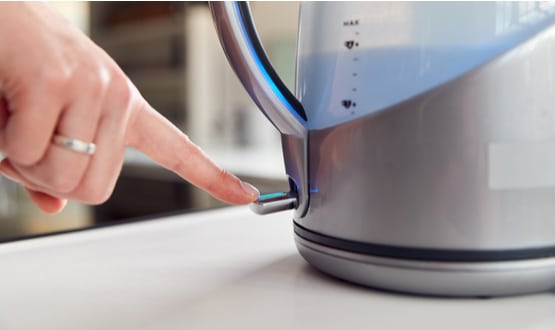Turning something as ordinary as switching on a kettle into health insight
- 22 February 2022

In a piece for Digital Health, Dr Haidar Samiei, clinical director at EMIS, explores how the pandemic has increased the trend for remote health monitoring and can help shape new ways of delivering healthcare.
I often joke that if I had remote access to my mum’s smart energy meter, I would be able to check up on her more easily. Peaks in her electricity usage could show me that she’s up and about, maybe having a shower, making a cup of tea. But any dips in energy usage would be just as helpful. If there’s been less than usual it would give me an idea that perhaps she hasn’t got out of bed yet and isn’t feeling very well.
But the truth is, I’m not really joking.
For years those of us who are digitally enabled have been able to record our step count, monitor our heart rate and track our calorie intake from our mobile device and smart wearables. We’ve also been able to gamify our health, using technology to compete with others or even just ourselves to achieve a personal best.
During the pandemic sales of wearable technology have gone through the roof, with spending due to increase globally from $69bn in 2020 to $81.5bn in 2021. The growth, according to forecasters, is due to an increased interest in monitoring our own health and wellness during lockdown and work from home trends.
According to a July 2020 Mintel report, there were then already more than 320,000 health and wellness apps and services available. Demand will only grow as more people take an active interest in maintaining and managing a healthier lifestyle.
Caring for loved ones remotely
So, isn’t it about time we started using this technology to help monitor the health and wellbeing of those we love, too?
Never was its need been more apparent than during lockdown, when we were restricted from seeing our vulnerable friends and family, many of whom had to isolate alone.
The good news is, it is an area of healthcare which is already flourishing. Dementia patients can now be monitored in their own home through integrated technology including monitors which record vital signs such as blood pressure, weight and hydration. Sensors installed throughout a patient’s home can monitor environmental changes and track movement – providing vital insight into someone’s everyday life and wellbeing. Apple watch can detect falls and inform next of kin. There are well documented, very human success stories in this space.
With social care stretched ever further with an ageing population, technology such as this is not only critical to public health, but also enables patients and families to maintain their independence for as long as possible.
Health data sharing gets the Apple treatment
Within healthcare we’ve been able to grant proxy access to health records to people acting on behalf of a patient, with either their legal consent or those with power of attorney for a while. But very soon health data sharing is set to become much more mainstream. In summer Apple announced its iOS 15 consumer health and wellness insights which has functionality for sharing with loved ones and those in a user’s care network.
Users of the iPhone and Apple Watch can privately share information such as heart health data, oxygen saturation levels or even qualitative mobility data through ‘Walking Steadiness’ which captures insight into fall risk.
Walking Steadiness uses custom algorithms to assess balance, stability, and coordination through built-in iPhone motion sensors. It’s the first metric of its kind having been developed using real-world data from the Apple Heart and Movement Study. The study observed more than 100,000 participants across all ages, and in turn was the largest data set ever used to study fall risk.
Transforming healthcare services
Remote monitoring technology is also transforming the way we design and deliver healthcare services.
During the pandemic, EMIS partnered with East Sussex CCG to roll out a tailored version of the EMIS Web system which enabled specialist GPs, cardiac physiologists and cardiographers to carry out remote consultations and manage cardiac patients at home.
Through data-sharing agreements with individual practices, GPs with a special interest in cardiology (GPwSIs) can view the patients’ full medical record held by their own GP, enabling more informed care.
It means they can assess patients to be fitted with heart monitors at home or in a community clinic rather than going to hospital. This could cut the waiting time from 18 weeks for a first out-patients appointment to six weeks for fitting by a community specialist team. The specialist team can also do echocardiograms. The aim is to keep cardiac patients out of hospital by offering timely, high-quality care close to where they live.
With permission from the user, smart wearables can also gather vital health data which can be shared with clinicians and carers.
Working in an emergency department I see lots of patients with complaints of heart issues. Sometimes these conditions present when I’m examining them, but occasionally they do not. In these cases I’ve had occasions when the patient has reached for their smartphone to show me they’ve been tracking their heart rate prior to visiting hospital. This is invaluable insight to both clinician and patient.
Medical grade wearables can provide clinicians with real time data about a patient instead of a snapshot during a GP or hospital appointment. They can track data 24 hours a day, seven days a week and algorithms can alert clinicians if something unusual is detected.
My earlier suggestion of accessing smart meters isn’t too off the wall either. In fact, earlier in the year 100 people who needed social care in Dorset entered a pilot to have their electricity usage, among other things, tracked to help identify potential health problems. And researchers did indeed look at how often patients switched on the kettle.
The benefit of remote monitoring goes far beyond caring for the individual. The real power of this data will start to be seen when we look at it on a broad scale. For example, if medical grade wearables were given to large numbers of patients prescribed a particular medication, we could analyse trends relating to that medication much more easily, such as efficacy or side effects, gaining insights and knowledge that can lead to positive change.
Analytics carried out at a large scale will help the healthcare industry make positive changes to public health, and it all starts with the data we can collect at individual patient level. Technology is the common thread – capturing valuable data can only benefit healthcare researchers, the health industry and the population as a whole.





1 Comments
The humble kettle’s place in Health IT history, this from 2013
https://www.digitalhealth.net/2013/10/joes-view-of-telehealth-for-dummies/
Remote monitoring could benefit from an app which rewarded volunteers who could go and knock on a door to see if the kettle data needed further inquiry.
Comments are closed.